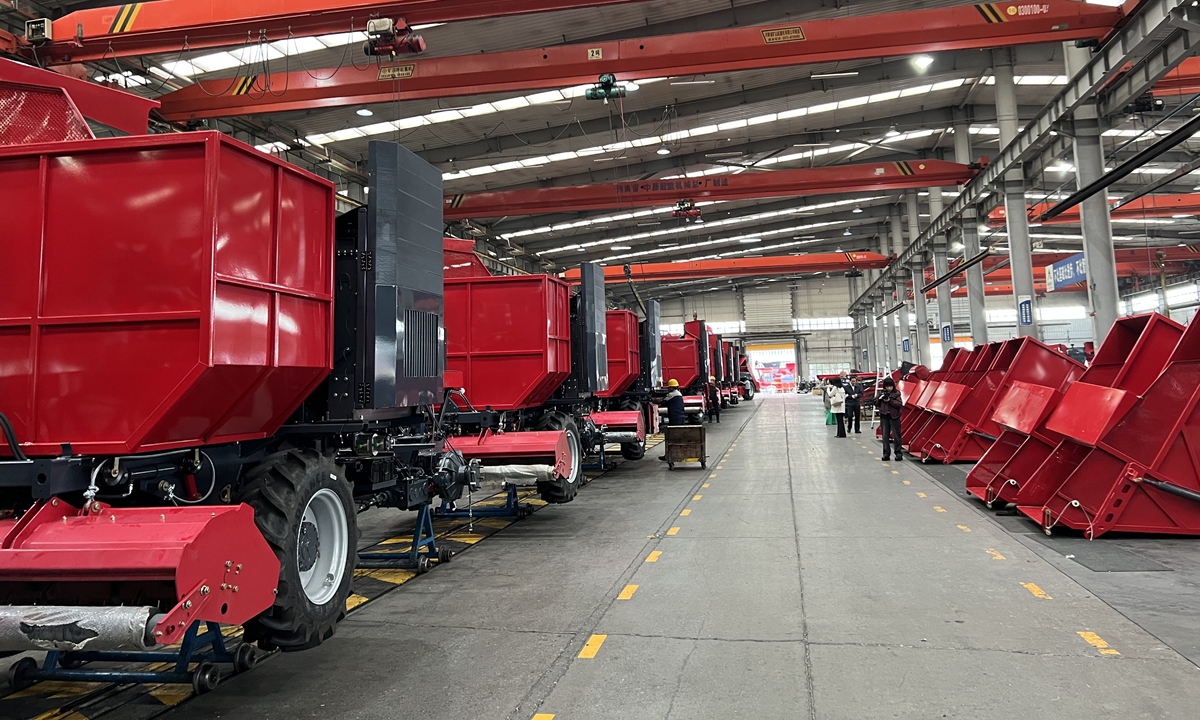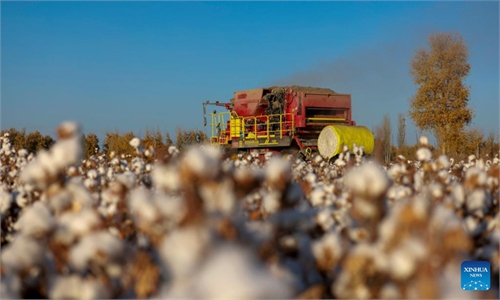Xinjiang sees steady rise in agricultural mechanization as autumn harvest season approaches

A view of intelligent corn harvesters produced by Xinjiang Machinery Research Institute Co being displayed at a factory in Urumqi, capital of Northwest China's Xinjiang Uygur Autonomous Region on September 15, 2023 Photo: Li Xuanmin/GT
As the harvest season approaches, Northwest China's Xinjiang Uygur Autonomous Region has seen a steady rise in the use of modern machinery including drone sprayers, intelligent harvesters connected with China's BeiDou Navigation Satellite System, as well as spectrometer screening, the Global Times learned.
It is estimated that the mechanization rate of cotton harvesting in Xinjiang could reach as high as 85 percent this year, and the rates for other crops such as pepper, corn and wheat could reach 65 percent, local officials said, which augurs well for China's autumn grain harvest and food security.
"The self-propelled pepper harvesters have all been sold out. Our production capacity is more than 100 machines a year, but the demand has far exceeded the supply as the agricultural mechanization rate in Xinjiang continues to grow," Xu Jiawen, manager of the operating management department at Xinjiang Machinery Research Institute Co, told the Global Times.
According to Xu, the leading reason is that local labor would cost much more than machinery. In the case of pepper farmland, hiring a pepper harvester is 350 yuan ($48.1) per mu (0.06 hectare), while it's about 1,800 yuan per mu for hand picking.
The company's intelligent corn harvesters have seen hot sales in recent days as the crop is ripening. The machines, which are connected with China's BeiDou Navigation Satellite System, could achieve automatic orientation.
Sensors and cameras are also installed in the front and back, providing real-time monitoring of the engines and the conditions of the grain tank, Xu said. The company is studying upgrading technologies to make the operation more intelligent, such as autonomous driving.
As demand for intelligent machinery booms in Xinjiang, the company's production capacity has doubled for three consecutive years. It is estimated that the revenue of Xinjiang Machinery Research Institute Co could hit 1.4 billion yuan in 2023, Xu said.
"We have seen the wider application of machinery in grain production in Xinjiang, which not only raises farming efficiency and yields, but also increases local farmers' income," Ding Zhijun, an official at the Urumqi Economic and Technological Development district, said.
In southern Xinjiang's Aksu Prefecture, an important cotton producing base, it is estimated that over 95 percent of the cotton farmlands have employed drones to spray defoliant, a necessary step for mechanized harvesting at a later stage, the Global Times learned from local agricultural drone sellers and farmers.
Cotton ripens in Xinjiang in October, when it will be harvested by intelligent cotton-picking machines. Xinjiang accounts for 85 percent of China's annual cotton yield.
Plantation drones are also used in other cotton growing procedures, including topping, spraying fertilizer and pesticide application, Luo Pengshan, a manager of a local plantation drone sales company who is also a drone operator, told the Global Times.
As the technologies of domestic cotton-picking machines are upgraded, Ding disclosed that local machinery firms have also made tentative moves to explore overseas markets, especially in Central Asia. For example, a company in Urumqi exported two cotton-picking machines this year to Uzbekistan.
Xinjiang has set a target of raising its farming mechanization rate to 85.8 percent in 2023, with that of cotton reaching 83 percent. Last year, the rate was 85.7 percent.
With farmland of over 100 million mu, Xinjiang is one of China's largest agricultural production bases. In 2023, the total output of summer grain in Xinjiang reached 7.01 million tons, up 460,000 tons from last year, hitting a new record.
Industry insiders expect a bumper harvest for 2023, as fall grain crops have been growing in most Chinese regions despite extreme weather conditions like summer floods.




